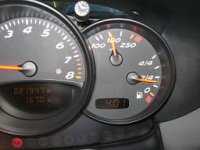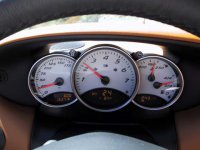Just what is the normal running temperature for a 98 Boxster? I bought it a few months ago when the ambient temperature was in the mid 20s and the gauge sat steady in the low 80s. Now that summer is here the gauge has climbed up to 90 (on hills, and idling around town). I'm assuming this is normal, but when should I start getting worried?
You are using an out of date browser. It may not display this or other websites correctly.
You should upgrade or use an alternative browser.
You should upgrade or use an alternative browser.
What temperature is normal?
- Thread starter Geoff
- Start date
- Messages
- 2,635
- Reaction score
- 4
- Points
- 0
Welcome!
I'm assuming that since you have mentioned Summer that you must be somewhere in the Southern Hemisphere, correct?
The "normal" range for most that have temp guages that read in Farenheit is about 180 with the needle pretty much in the middle.
I'm assuming that since you have mentioned Summer that you must be somewhere in the Southern Hemisphere, correct?
The "normal" range for most that have temp guages that read in Farenheit is about 180 with the needle pretty much in the middle.
- Messages
- 125
- Reaction score
- 0
- Points
- 0
Some variance is normal.
Sounds like you are driving a non-USA car, so I'm not sure exactly how the tick marks are labeled and positioned. However, on the USA cars we have a 180°f (82°c) tick mark that is slightly left of center, a 250°f (121°c) mark at the far right with a red light, and an unlabeled tick mark in between (so, approximately 215°f or 102°c).
My experience is that the needle straight up is "normal". However, it is also normal for the temperature to rise in the kind of conditions you describe (hot weather, stop-and-go traffic, hill climbing). Up to the unlabeled 215°f tick mark is perfectly OK. If it starts going above that, then there may be a problem. The flashing red light and the 250°f mark are the ultimate sign of overheating.
I think that the Boxster temperature gauge is wonderfully sensitive, and suspect that many other cars have some kind of internal trickery to keep the needle from moving at all unless there is a big problem. This can lead new Boxster drivers to worry if the needle moves up a little bit because they are not used to seeing temperature gauge movement. But it can be very useful on the race track, because driving behavior (especially on hot days) can have immediately noticeable effects on engine temperature, and you can adapt if need be. On at least one occasion, on a 95°f+ degree outside temperature day at the track, I noticed the gauge getting a little too far beyond the 215°f mark for my comfort, so I did a little short-shifting for half a lap, and the saw the needle ease back down almost immediately! This told me that there was no big problem such as coolant loss, just a bit more heat than usual.
Sounds like you are driving a non-USA car, so I'm not sure exactly how the tick marks are labeled and positioned. However, on the USA cars we have a 180°f (82°c) tick mark that is slightly left of center, a 250°f (121°c) mark at the far right with a red light, and an unlabeled tick mark in between (so, approximately 215°f or 102°c).
My experience is that the needle straight up is "normal". However, it is also normal for the temperature to rise in the kind of conditions you describe (hot weather, stop-and-go traffic, hill climbing). Up to the unlabeled 215°f tick mark is perfectly OK. If it starts going above that, then there may be a problem. The flashing red light and the 250°f mark are the ultimate sign of overheating.
I think that the Boxster temperature gauge is wonderfully sensitive, and suspect that many other cars have some kind of internal trickery to keep the needle from moving at all unless there is a big problem. This can lead new Boxster drivers to worry if the needle moves up a little bit because they are not used to seeing temperature gauge movement. But it can be very useful on the race track, because driving behavior (especially on hot days) can have immediately noticeable effects on engine temperature, and you can adapt if need be. On at least one occasion, on a 95°f+ degree outside temperature day at the track, I noticed the gauge getting a little too far beyond the 215°f mark for my comfort, so I did a little short-shifting for half a lap, and the saw the needle ease back down almost immediately! This told me that there was no big problem such as coolant loss, just a bit more heat than usual.
- Messages
- 2,635
- Reaction score
- 4
- Points
- 0
I think a picture is the best explanation here. Here's a picture of the temperature guage in my boxster (taken today).
Yes, this is what mine looks like as well. Bob / Colorado
Just what is the normal running temperature for a 98 Boxster? I bought it a few months ago when the ambient temperature was in the mid 20s and the gauge sat steady in the low 80s. Now that summer is here the gauge has climbed up to 90 (on hills, and idling around town). I'm assuming this is normal, but when should I start getting worried?
80 to 90 sounds about right - the fact that you mention summer, I'm guessing you're in Australia ? because its snowing here in Ireland
Thanks guys, that puts my mind at rest a bit. Its an ex-japan car with the temperature gauge in celcius (40/80/120) but I can see from the pictures the needle position. Its a great summer in New Zealand, haven't seen rain for months.
 Geoff
Geoff
Last edited:



